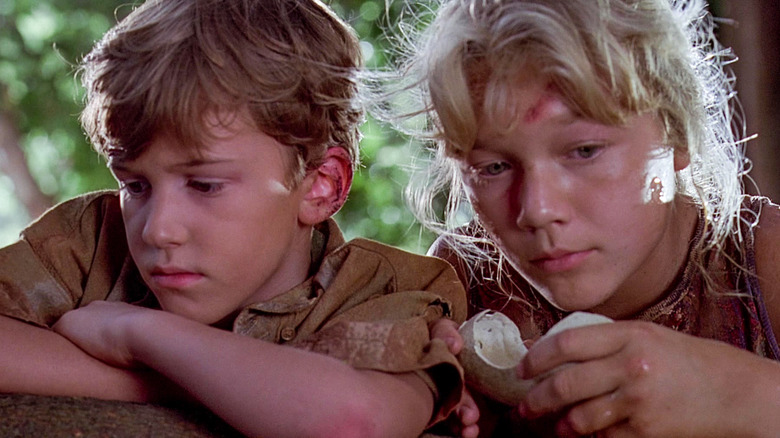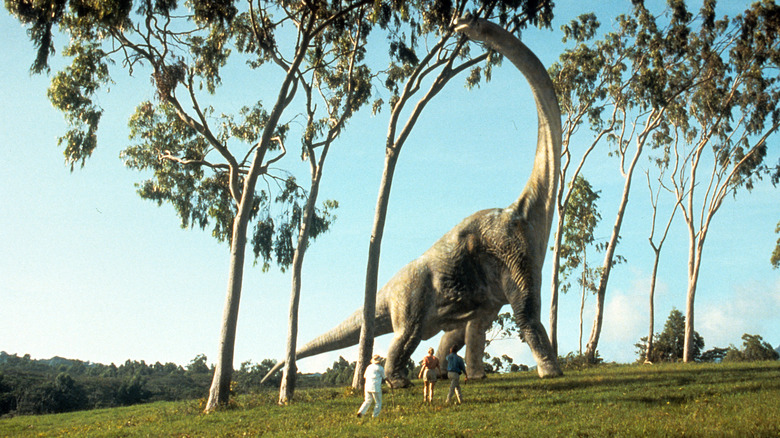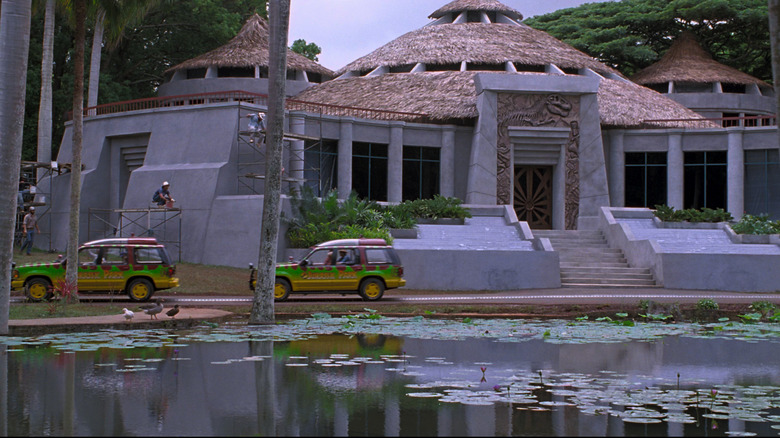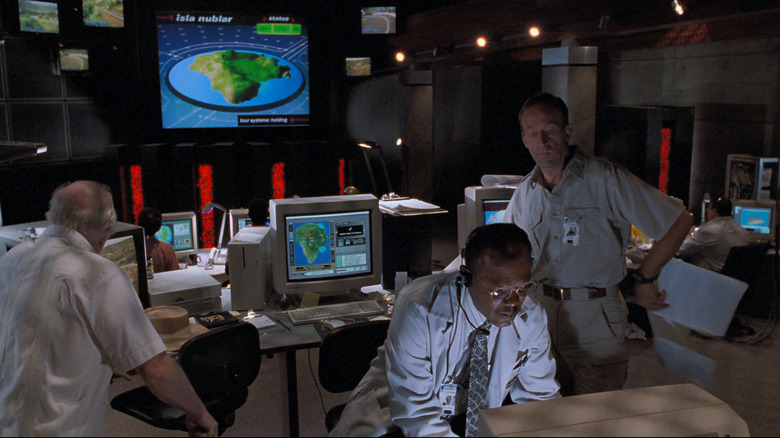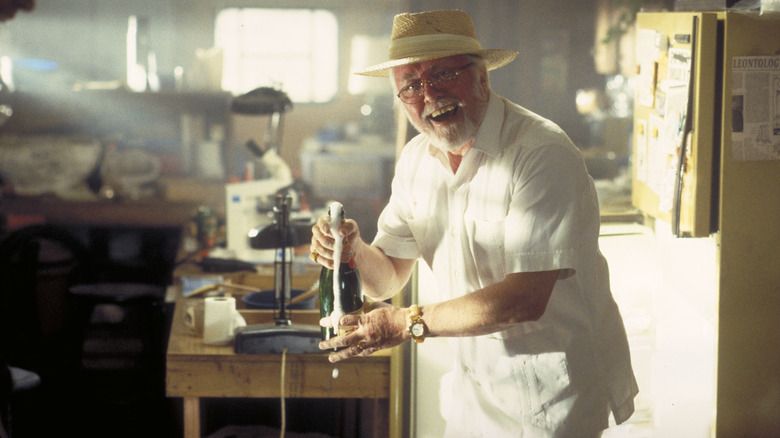Could Jurassic Park Have Been A Viable Business? An Investigation
30 years ago, Steven Spielberg's "Jurassic Park" managed to make dinosaurs feel far more real than they ever had before. While the whole venture goes sideways, billionaire John Hammond, played by the wonderful Richard Attenborough, had a vision of bringing these creatures to life for the world to enjoy, imagining a dino Disneyland of sorts on a Costa Rican island far from the mainland. What could go wrong?
It turns out, humans and dinosaurs don't mix well. But we all know that story. What remains a bit unexplored all these years later is whether or not Hammond's vision, in 1993, could have worked as a viable business. Yes, 2015's "Jurassic World" showed us a version of the park operating years later, but that looked to be far more advanced (and expensive) than what Hammond had in mind.
So let's take a look back and use what information we have available to try and figure out if Hammond's park, as designed, could have actually made money. Or, at the very least, broken even so that Hammond wasn't bleeding cash. Granted, we'll have to do some oversimplifying here and do some guesswork, but let's see if we can at least get in the ballpark.
What would it cost to build Jurassic Park?
The biggest question one would need to answer to determine whether or not "Jurassic Park" could function as a business is how much it would cost to build it in the first place. A Fandango Movieclips video did the brutal legwork on that one back in 2015 around the time that "Jurassic World" was coming out. We'll be using that video's numbers as a baseline, and they determined that, between buying the Costa Rican islands, creating the dinosaurs, staffing up the island with scientists, and actual construction costs, the park would cost around $23.4 billion. Additionally, it's estimated that it would cost around $11.9 billion annually to keep the park running.
That, however, is using 2015 numbers. If we account for the rate of inflation between 1993 and 2015, those numbers are reduced pretty significantly. In '93 dollars, the cost to build the park would be around $14.2 billion, while the annual operating costs would come in around $7.25 billion. That's still a tremendous amount of money that someone was expecting to earn back once the park had opened. Granted, Hammond surely invested a great deal of his own money, but as the lawyer Donald Gennaro (the one who gets eaten off the toilet by a T-rex) explains in the film, there are investors who have a stake in the endeavor.
Hammond had his own ideas — as he wanted the park to be available to everyone, not just the super wealthy. This is why Gennaro jokes they could have a "coupon day" in the film. But Hammond's determination not to price gouge needs to be taken into account here, as he was the figure at the head of this whole operation.
How much would John Hammond charge to visit the park?
We need to estimate how much money each guest would spend while they were at an actual, functioning dinosaur theme park on food, lodging, merchandise, and other revenue streams, which would be a huge factor. Particularly because guests would be land-locked on Isla Nublar, so they would probably need to stay at a hotel on the island and may not have a wide array of dining options beyond what the park had available. So that would certainly account for a large portion of daily revenue. More on that in a moment.
Based on the estimated operating costs, the park would need to make close to $20 million per day to cover expenses. That doesn't account for recouping the billions in setup costs. So, the big question: How much would Jurassic Park charge for admission? Amazingly, we do kind of have an official answer to this question, which takes us a long way in figuring out how Hammond could turn a profit (or perhaps not).
Back in 2019, some officially licensed "Jurassic Park" merchandise was released in the form of a Visitor Centre Limited Edition Legacy Kit. In that kit was a three-day pass with a price of $550 listed on it. Unfortunately, we didn't get prices for single-day passes or differences in adult pricing versus kid pricing. But what this did tell is that Hammond wasn't going to set the price to get in the door as astronomical. He was good to his word on that one. Though, in 2023 money, that would be a little over $1,100. Still, for what is being offered, one imagines that the price could be far higher. After all, Hammond spared no expense.
The park's potential daily revenue
Next, what we need to determine is what percentage of the revenue per guest the ticket would account for. Obviously, we don't have any accounting statements from the folks at InGen to look over. What we can do, though, is look at another massive theme park — in this case Disneyland — and use that as a basis for comparison. According to Urban Tastebud, here's a breakdown of the average per-guest cost at the California park.
-
Park Tickets: Starts at $104 per day
-
Food and Drinks: $70 per day per person
-
Hotels and Resorts: $415 to $675 per night
I am not including transportation costs as visitors wouldn't have to travel around a city, nor am I including a park-hopper upgrade or off-site hotel costs, since we're dealing with an island. Also, I'm going to use the low-end hotel cost and estimate that the average room would have 3 guests in it. With that, we get to around $312 per person per day at Disneyland (not counting merchandise).
Using that $550 three-day ticket cost, we can estimate $183 per day per guest for a visit to Jurassic Park. If we assume that the ticket cost would make up the same percentage of the daily cost for the average visitor, then Hammond could expect around $549 from each guest per day, give or take.
So how many guests per day could Jurassic Park accommodate? Disneyland is 40 square miles and has an 85,000-person capacity. According to a 2020 report (per THR), Disneyland needs to hit 25% capacity to break even. We can probably assume that Hammond and his investors would set a similar break-even point in the business model. Isla Nublar is around 22 square miles, meaning it could probably handle approximately half of Disneyland's max guest capacity.
The verdict
Now we're finally getting somewhere. Let's assume for the sake of argument that the park's max capacity would be 42,500 people. We're also going to assume that Jurassic Park would have a higher break-even floor, given the logistics of getting people to and from the island. That being the case, let's look at what the park could, in theory, generate at 50% capacity annually, if we assume the park is open 365 days per year.
Not counting merchandise revenue (which would surely be a huge factor), using our $549 per day figure, Jurassic Park could theoretically net $11.66 million per day, getting us to nearly $4.26 billion annually. That is a far cry from the $7.25 billion annually we estimated earlier to cover operating costs. However, merchandise, licensing opportunities, premium experiences at the park, and other ancillary revenue streams would be in play. So it's at least conceivable that the business could at least break even — especially if the park were over 50% capacity on average each year. And that might be a conservative estimate. After all, we are talking about seeing real live dinosaurs here.
In conclusion? John Hammond's dream of bringing dinosaurs to life for the world to experience as the center of a functional business may not be as crazy as it sounds. You know, setting aside the death and danger of it all that derailed the whole thing in the first place. The path to profit would be narrow in keeping corporate greed out of the equation, but not impossible. Life finds a way, as it were.
